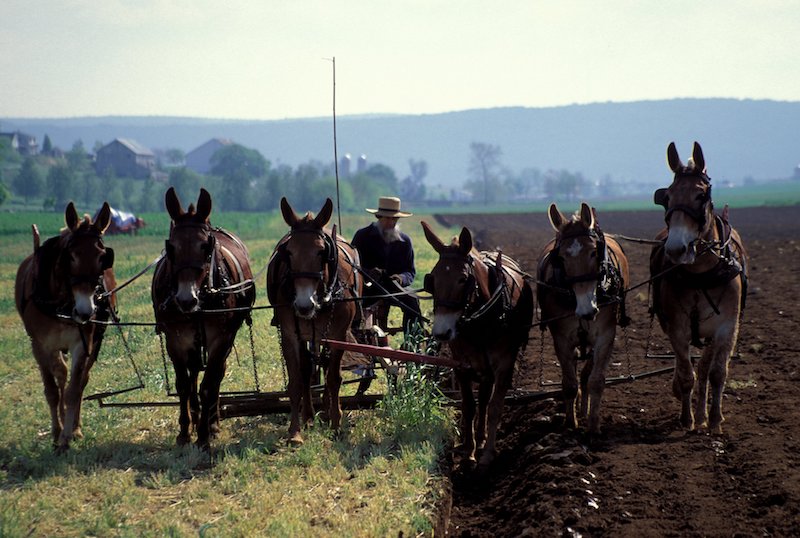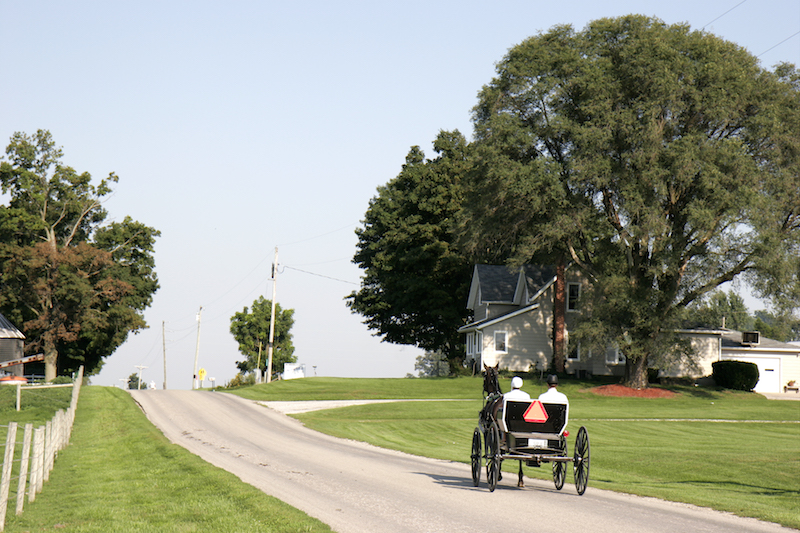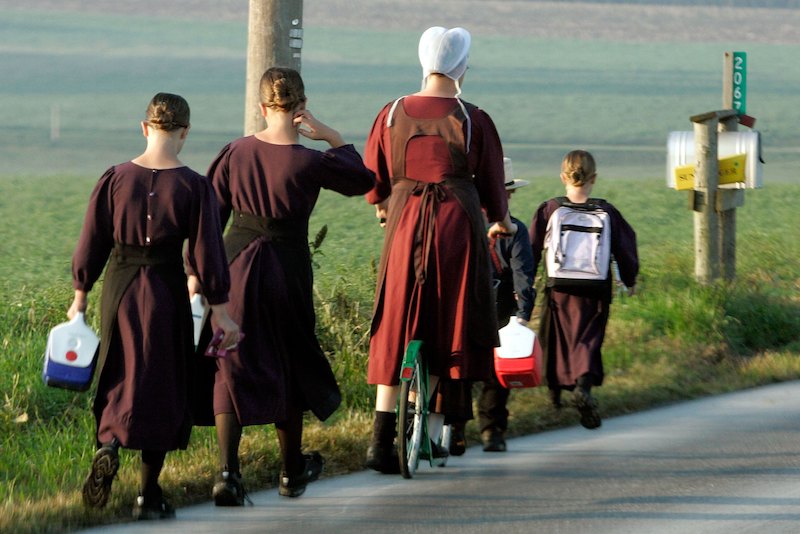So she didn’t.
Even on the day the police showed up on her doorstep to question then-12-year-old Sadie’s father about his alleged abuse of his daughters.
Even on the day when, almost two years later, Abner was sentenced by a circuit court judge to just five years’ probation.
And even on the day when, at 14, she says she was cornered in the pantry by one of her brothers and raped on the sink, and then felt a gush and saw blood running down her leg, and cleaned up alone while he walked away, and gingerly placed her underwear in a bucket of cold water before going back to her chores. A friend helped her realize years later: While being raped, she had probably suffered a miscarriage.
It wasn’t until now that Sadie decided to speak up, to reveal the darkness beneath the bucolic surface of her childhood. She’s tired of keeping quiet.
Over the past year, I’ve interviewed nearly three dozen Amish people, in addition to law enforcement, judges, attorneys, outreach workers, and scholars. I’ve learned that sexual abuse in their communities is an open secret spanning generations. Victims told me stories of inappropriate touching, groping, fondling, exposure to genitals, digital penetration, coerced oral sex, anal sex, and rape, all at the hands of their own family members, neighbors, and church leaders.
The Amish, who number roughly 342,000 in North America, are dispersed across rural areas of states like Pennsylvania, Ohio, Indiana, Kentucky, New York, Michigan, and Wisconsin, according to the Young Center for Anabaptist and Pietist Studies at Elizabethtown College, a leading authority on Amish life. Because of their high birth rate—and because few members ever leave—they’re one of the fastest-growing religious groups in America. Lacking one centralized leader, they live in local congregations or “church districts,” each made up of 20 to 40 families. But the stories I heard were not confined to any one place.
In my reporting, I identified 52 official cases of Amish child sexual assault in seven states over the past two decades. Chillingly, this number doesn’t begin to capture the full picture. Virtually every Amish victim I spoke to—mostly women but also several men—told me they were dissuaded by their family or church leaders from reporting their abuse to police or had been conditioned not to seek outside help (as Sadie put it, she knew she’d just be “mocked or blamed”). Some victims said they were intimidated and threatened with excommunication. Their stories describe a widespread, decentralized cover-up of child sexual abuse by Amish clergy.
“We’re told that it’s not Christlike to report,” explains Esther*, an Amish woman who says she was abused by her brother and a neighbor boy at age 9. “It’s so ingrained. There are so many people who go to church and just endure.”
And yet, as #MeToo has rocked mainstream culture, Amish women have instigated their own female-driven movement. “It’s much slower and less highly visible,” says Linda Crockett, founder and director of Safe Communities, an organization that works to prevent child sexual abuse. “But I have seen a real uptick over the past 10 years in Amish women coming forward. They hear about each other—not on Twitter or Facebook, but there’s a strong communication system within these communities. They draw courage and strength from each other.”

Image: Jeff Greenberg/Universal Images Group via Getty Images
“I get phone calls now….There’s a bunch of Amish who have my cell phone number, and they use it. The men call on behalf of the women,” says Judge Craig Stedman, former district attorney of Lancaster County, Pennsylvania—home to nearly 40,000 Amish—who has served on a task force that connects the Amish to law enforcement and social services. (Although most don’t have cell phones, the Amish might use pay phones or call from “English” neighbors’ homes.)
Some victims, like Sadie, have long since left the church and the Amish way of life, but others, including Esther, are still on the inside, sending out an alarm to the world they’ve been taught to reject. “They want to talk,” explains Crockett, “so they’re turning outside.”
There’s no one reason for the sexual abuse crisis in Amish Country. Instead, there’s a perfect storm of factors: a patriarchal and isolated lifestyle in which victims have little exposure to police, coaches, or anyone else who might help them; an education system that ends at eighth grade and fails to teach children about sex or their bodies; a culture of victim shaming and blaming; little access to the technology that enables communication or broader social awareness; and a religion that prioritizes repentance and forgiveness over actual punishment or rehabilitation. Amish leaders also tend to be wary of law enforcement, preferring to handle disputes on their own.
As a child, Sadie was up before dawn every morning to milk her family’s cows, wearing a pleated head covering and long dress, her shoes and socks a dull black, as her local church rules, or Ordnung, required. “If you didn’t work as hard as you possibly could, you were considered lazy,” she says. She never turned on a light switch or shopped for clothes in a store. She didn’t speak English at home—just Pennsylvania Dutch, the only language she knew until first grade. And she never revealed her abuse to anyone, except a cousin and her father himself, when he asked her, point blank, if her brothers were touching her. (The next time he asked, she lied, fearful he would beat the boys, as he often did.)
But what was happening in her house was a poorly kept secret, according to several of Sadie’s relatives. One of them reported Abner, who has since died, to local church leaders—Sadie remembers her father being “shunned” for six weeks, a common form of discipline in which the accused is socially ostracized and forbidden from eating at the same table as church members. After a shunning, the person confesses in church and the community is strongly compelled to forgive and forget that the “sin” ever happened. In Sadie’s house, she recalls, everything went back to normal—or at least, to how it had been before.

Image: Jeffrey Greenberg/Universal Images Group via Getty Images
When the police and social workers later showed up on her doorstep, most likely after being tipped off by a local non-Amish person, Abner told authorities that “things which we were speaking about had been brought up and dealt with in the church,” according to a police detective’s notes. He also silenced his daughters. “You say nothing,” Sadie and another relative remember him demanding.
Authorities returned a second time, asking him “specific questions about having sexual intercourse with his daughters,” according to the case file. Now Abner confessed to having “sex with two of them,” insisting “he made love to them at least three times each but didn’t hurt them.” Sadie, who had heard from a cousin that her dad was also abusing her sisters, didn’t dare breathe a word in their defense.
A relative recalls that Sadie’s mother told social workers “to do whatever they could to keep him from going to jail.”
It worked. A grainy VHS recording from 2001 shows a gray-bearded Abner standing with his hat hanging between his hands before a judge, as an attorney explains that he is pleading guilty to a reduced charge of sexual abuse in the first degree, and not incest, because “the family is not desiring that he be incarcerated.” Instead of serving a sentence that might have been five years or more, Abner got probation.
Sadie says her father abused her for five more years. When I reached out to her brothers, two confirmed that Abner had touched Sadie; one of them also said he himself “messed around” with her when they were young but that he did not rape her; the other denied raping her. A third brother did not respond to a request for comment.
Some victims aren’t just silenced—they suffer something worse. Lizzie Hershberger was 14 when she went to work as a “maude,” or hired girl, for a 27-year- old Amish man named Chriss Stutzman and his wife, taking care of their four children and helping Stutzman in the barn. One night after they had milked the cows, he pinned her against a wall and kissed her, then pushed her onto the feed bags. Because it was a frigid winter in Minnesota, Lizzie wore pants under her dress, which Stutzman removed while she tried in vain to fight him off. “Relax,” he whispered into her ear as he raped her. (To this day, that word remains a trigger for Lizzie.)
She didn’t know why she felt pain and blood between her legs. Her parents had never talked to her about sex or even her period. (When Sadie got her period at age 10, while playing outside, she remembers stuffing toilet paper in her underwear and pulling one of her sisters into the outhouse to ask what was going on.)
“Amish victims don’t even know the names of body parts,” confirms Stedman. “To describe a sexual assault without having any fundamental sex education, it presents even more challenges.”
When Lizzie’s abuser finally climbed off her, she was shaking. “I felt broken and used and dirty,” she says. “I was already blaming myself, thinking, Why didn’t I leave the barn just, you know, a couple of minutes earlier?” Stutzman would rape Lizzie 25 more times over roughly five months, according to court records and Lizzie’s diary. He raped her in the hayloft, in his house, and on the seat of his buggy. Once, on the way home from church, he pulled the buggy off the road and raped her in the woods. (Through his lawyer, Stutzman declined to comment.) Twice, male witnesses walked in on the abuse, but neither man came to Lizzie’s rescue.

Image: Mark Wilson/Getty Images
Instead, Stutzman himself, perhaps sensing he’d been caught, confessed.
Like Abner, he was shunned for six weeks. And again, no one reported him to outside authorities, especially since the church had already disciplined and forgiven him. Instead, the community turned on Lizzie for what they saw as a consensual “affair.” She was bullied and mocked, spit on and called a “schlud” and “hoodah” (Pennsylvania Dutch for “slut” and “whore”). “They didn’t ask me how I felt or my side of the story,” she says. Instead, the community gossiped that she had “mental issues.”
It’s common for Amish victims to be viewed by the community as just as guilty as the abuser—as consenting partners committing adultery, even if they’re children. Victims are expected to share responsibility and, after the church has punished their abuser, to quickly forgive. If they fail to do so, they’re the problem.
When the rare case does end up in court, the Amish overwhelmingly support the abusers, who tend to appear with nearly their entire congregations behind them, survivors and law enforcement sources say. This can compound the trauma of speaking out. “We’ve had cases where there’ll be 50 Amish people standing up for the offender and no one speaks for the victim,” says Stedman.
In one 2010 case, young female victims were pressured to forgive their father and brother for abusing them, with one writing a pleading letter to the court (“Hello Sir, I’m Melvin’s sister. Please have mercy. Melvin has made a big change to let go of his committed crime in the last year. I’d like to have our family together.”), recalls former President Judge Dennis Reinaker, who has presided over 30-plus Amish sexual assault cases in Lancaster County. In this case, the victims agreed to cooperate only in exchange for their abusers receiving no jail time. The deal likely helped save the defendants from what could have been 25- to 30-year prison sentences, says Reinaker.
Things got stranger for Lizzie.She remembers her mother telling her that she was being taken to a chiropractic clinic in neighboring South Dakota, and then boarding a bus full of Amish adults for the 300-mile drive to a facility where, for a week, “they watched me all the time,” she says. She received daily deep-tissue massages to “work through my emotional stuff,” she was told.
Lizzie’s is not the only account of an Amish victim being taken to an alleged “mental health” facility staffed by Amish or Mennonites (a similar, although typically less strict, group) that provides Bible-based counseling—and, in many cases, is not state licensed. Several years ago, Esther was sent to a facility for “counseling” after she tried to seek help for another Amish woman who was being sexually assaulted. When she protested, church leaders threatened to excommunicate her permanently.
No one would tell her why she was there. Instead, she was pressured to sign papers that would allow staff to communicate directly with her ministers, she says (she eventually gave in and signed). “From the first evening, they wanted to put me on medication,” she recalls. She said no, since “a lot of these people who get stuck in these facilities come home drugged and no longer have a life. They’re zombies.” (She’s aware of about 30 other Amish sexual assault victims, including two of her sisters, who have been sent away to such facilities.)
Eventually, Esther says she was told that refusing “sleep medication” would only prolong her stay. When she asked about side effects, a house parent told her, “It doesn’t matter— you have to take it.”
So she did. Except the drugs weren’t for sleep at all: According to her medical records, she was prescribed olanzapine, an antipsychotic medication that treats mental illnesses like schizophrenia. Every morning and night, she and other Amish patients lined up to receive their drugs. “We’d have to go and fill a small container with water and then go up to this pedestal; we’d all take turns,” she says. “It was gut-wrenching.”
- It’s common for Amish victims to be viewed by the community as just as guilty as the abuser—as consenting partners committing adultery, even if they’re children.
Esther started having blurry vision and hallucinations. She wanted to escape—but she knew that defying her ministers would get her kicked out of the church. She was ultimately on the drug for two weeks of her five-week stay. Her discharge notes recommended she “be submissive” and that she “challenge unhealthy thoughts toward ministers and others using positive/good thought.”
Esther now says Amish leaders use lockup stays to silence women who are increasingly eager to go public with abuse allegations. “When a victim speaks out,” Esther explains, “they get sent to a facility and drugged so that they shut up.”
Still, as more and more women start to come forward, an ecosystem has also risen up to help them. Two years ago, Lizzie, who has long since left the Amish, and another former Amish woman named Dena Schrock launched Voices of Hope, a group for abused women. Lizzie met Sadie at one such gathering, and they’re now friends.